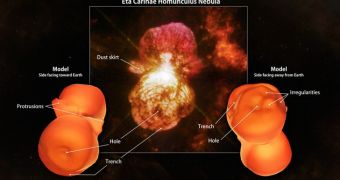This past July 8, NASA (the National Aeronautics and Space Administration in the United States) announced the creation of the first full three-dimensional model of the Eta Carinae Nebula.
The model is the brainchild of an international team of researchers, who used data and images obtained with the help of the European Southern Observatory's Very Large Telescope and its X-shooter spectrograph to piece it together.
In a press release on the matter at hand, NASA details that, although first assumed to be a single star, Eta Carinae is actually a binary system. That is, it comprises two stars that sit very close to one another and orbit a common center of mass.
The system is located at a distance of about 7,500 light-years from Earth, and it is one of the most massive structures of this kind astronomers have until now had the chance to study.
Thus, investigations carried out over the years have show that one of the two stars that make up this binary system has a mass about 90 times greater than that of the Sun. What's more, it is estimated to emit about 5 million times more energy than the Sun does.
The other star that is part and parcel of the Eta Carinae binary system is believed to pack the equivalent of about 30 solar masses and to, therefore, be about 1 million times more luminous, astronomers explain.
Back in the 19th century, between the years 1838 and 1845, Eta Carinae experienced a major eruption. Simply put, it coughed out a gaseous shell estimated to have packed the equivalent of somewhere between 10 and 40 solar masses.
Following this impressive cosmic burp, the binary system came to be surrounded by a twin-lobed cloud dubbed the Homunculus Nebula. This cloud measures about one light-year in length, and is still expanding at roughly 1.3 million miles per hour (2.1 million kilometers per hour).
Having created a three-dimensional model of the dust-filled cloud around binary system Eta Carinae, astronomers found evidence that the Homunculus Nebula owes its fairly peculiar shape to interactions between the two stars.
“For the first time, we see evidence suggesting that intense interactions between the stars in the central binary played a significant role in sculpting the nebula we see today,” said Thomas Madura, a NASA Postdoctoral Program fellow at NASA's Goddard Space Flight Center in Greenbelt, Maryland.
By the looks of it, the Homunculus Nebula is not exactly what some would call smooth and symmetric. On the contrary, its lobes both sport holes at their ends and even have odd protrusions sticking out of them. Besides, deep trenches are present on each of the lobes.
“The new features strongly suggest that interactions between Eta Carinae's stars helped mold the Homunculus,” Jose Groh, an astronomer at Geneva University in Switzerland commented on the outcome of this research project.
Astronomers expect that their model of the Eta Carinae Nebula will help them gain a better understanding of binary systems and how they shape the universe around them. A detailed account of this investigation is published in the journal Monthly Notices of the Royal Astronomical Society.
Check out the videos below to learn more about how the three-dimensional model was created and get a better look at binary system Eta Carinae and its accompanying dust-filled cloud.

 14 DAY TRIAL //
14 DAY TRIAL // 
